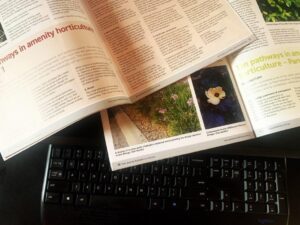
Freelancing for a career in the media
By Daniel Fuller
Did you realise that people are making a part-time and eventually a full-time wage creating horticultural content like writing articles, creating videos, and taking photos?
You could be supplementing your own wage, or at least earning a little bit of extra pocket money while exercising a different type of creativity. You just need to formulate a plan, build a portfolio, and source paying clients.
Recently, I interviewed Chloe Thomson on my podcast about her career in horticulture media as a freelancer. Chloe is the face behind the Bean There Dug That brand, which you may recognise from social media and YouTube. Chloe hosts the Behind the Garden Gate series on her YouTube channel, has presented for the Garden Gurus, has spoken on the main stage at MIFGS, and created the Sprout School online education platform.
Freelancing means that you work under your own ABN for a few different companies. In a horticulture media context, this can include presenting at industry events, radio, video production, photography, writing, and audio content for a variety of different platforms. This includes company websites, branding material such as flyers, social media, YouTube, blogs, magazines, podcasts and more.

You shouldn’t expect to make an income from freelancing in horticulture media straight away. Some people will tell you never to do free work, but I personally disagree with this. Very few employers will want to pay for you to learn, and why should you feel entitled to a role you haven’t earned yet? Most of us need to build a body of work to sharpen our skills and to show clients we’re a good investment.
In my own experience, I wrote 50 blog articles on my own website, recorded and released over 100 podcast episodes, and volunteered to write the “careers” column at the Journal here for a couple of years before I started charging for my services podcasting, writing, and creating video content for well-known brands in our industry.
Now I help businesses reach the front page of Google on targeted search terms (SEO), write their advertising material for publication, and gain their clients’ attention with short form videos for LinkedIn, YouTube, TikTok, Instagram and Facebook as well as long-form videos for YouTube. As well as this, I also host in-person presentations and webinars for landscape architects and TAFE students.
With my podcast, I collaborate with sponsors on long-form podcast content to educate my industry-based audience on their area of expertise, inadvertently positioning them as the leaders of their space. Some of my sponsors include GLG, Arborgreen, Charlie Carp, the Australian Institute of Horticulture and Hort Journal Australia.
Just like with most aspects of horticulture and landscaping, your earlier work will be clunky and you’ll learn a lot creating your first few pieces of work. Chloe and I both cringe when we view our earlier work after having improved our skills over the years.
It’s a good idea to find a mentor, someone who has experience, and has gained respect in your industry. They’ll be able to provide feedback to help you create content that impresses clients rather than turn them off.
As you build your body of work, you’ll need to consider your personal brand. What do you represent, and what are you comfortable with?
For example, how do you feel about writing articles on the benefits of chemical pesticides? Do you want your face to be a big part of your brand, as in video, or would you prefer to be a bit more private and focus on the writing and plant photos instead? There’s no right or wrong answer, just different options for you to pursue.
You can niche down, or you can generalise. A past guest of my podcast, Megan Webb, is known as the Carnivorous Plant Girl, and as such would be the first port of call for a company that wants to create content about that topic. However, the trade-off is that niching down can prevent you gaining work that you’re capable of doing well but which is off-brand for you.
There are plenty of different types of content to focus on as you build your personal brand and portfolio. You may find that you gravitate to one type of content or another, or you may find the market guides you to a gap you’re able to fill.
If your horticultural experience is in the tropics and you focus on writing articles for a Mediterranean or temperate climate, you’ll be blind to the gaps in your own knowledge. This means you’ll have to do extra research, and you’re more likely to make factual errors based on assumptions from your own history. Instead, consider focusing on your strengths.
You can gain your first few clients by reaching out to your network. Who do you know that works in a place that could benefit from your services?
After that, you can cold contact potential clients through email or phone. Start by making a list of companies, publications and other organisations in the space you could work with. Then use Google to increase this list. Keep track of your outreach using a CRM (Customer Relationship Manager) program like HubSpot so you can write notes for each interaction. It’s incredible how little you’ll remember about an interaction after a few weeks unless you take notes and file them for easy access.
During outreach, focus on value for the client, not on yourself. Take the time to research the client, get a feeling for their brand voice, what sort of content they release, and gain an understanding of who they target. Focus on what’s in it for them, instead of how you’re passionate about writing, or how you need more clients. It takes a bit of emotional intelligence to craft a compelling personalised cold outreach.
There are online platforms like Fiver and Upwork where you can bid on freelancing jobs with others from around the world. While there are good clients on these platforms, a lot of people have more luck cold contacting companies rather than competing with overseas freelancers living in countries with a different salary expectation.
Once you have a proven track record with clients, you may gain work through word of mouth. This can happen organically as the client raves about your work to their network, but you shouldn’t be afraid to directly ask them for referrals.
The bigger and higher value your network is, the easier it will be for you to build a list of paying clients. Attend networking events as they are invaluable for building relationships that can blossom into successful working relationships.
You can start working on a blog, social media account, or YouTube channel today, just to see if you even like it. Find some spare time to commit to regularly creating work, whether that’s an hour before work every morning, or you set aside a half day each week.
Whether your goal is ultimately to earn some pocket money doing something you love on the weekends, a full-time freelancing career, or you have grandiose visions of running your own agency one day, freelancing is something that people like Chloe and I make a living from. And it might be something that you can make a living from, too.
If any of what I have written resonates with you or your business please don’t hesitate to reach out and make contact
Daniel Fuller
M: 042 6169 708
E: hello@plantsgrowhere.com
